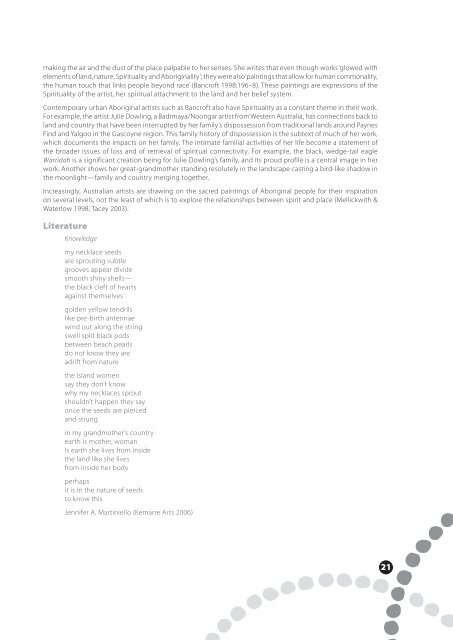DP9-Aboriginal-Spirituality
DP9-Aboriginal-Spirituality
DP9-Aboriginal-Spirituality
Create successful ePaper yourself
Turn your PDF publications into a flip-book with our unique Google optimized e-Paper software.
making the air and the dust of the place palpable to her senses. She writes that even though works ‘glowed with<br />
elements of land, nature, <strong>Spirituality</strong> and <strong>Aboriginal</strong>ity’; they were also ‘paintings that allow for human commonality,<br />
the human touch that links people beyond race’ (Bancroft 1998:196–8). These paintings are expressions of the<br />
<strong>Spirituality</strong> of the artist, her spiritual attachment to the land and her belief system.<br />
Contemporary urban <strong>Aboriginal</strong> artists such as Bancroft also have <strong>Spirituality</strong> as a constant theme in their work.<br />
For example, the artist Julie Dowling, a Badimaya/Noongar artist from Western Australia, has connections back to<br />
land and country that have been interrupted by her family’s dispossession from traditional lands around Paynes<br />
Find and Yalgoo in the Gascoyne region. This family history of dispossession is the subtext of much of her work,<br />
which documents the impacts on her family. The intimate familial activities of her life become a statement of<br />
the broader issues of loss and of retrieval of spiritual connectivity. For example, the black, wedge-tail eagle<br />
Warridah is a significant creation being for Julie Dowling’s family, and its proud profile is a central image in her<br />
work. Another shows her great-grandmother standing resolutely in the landscape casting a bird-like shadow in<br />
the moonlight—family and country merging together.<br />
Increasingly, Australian artists are drawing on the sacred paintings of <strong>Aboriginal</strong> people for their inspiration<br />
on several levels, not the least of which is to explore the relationships between spirit and place (Mellickwith &<br />
Waterlow 1998; Tacey 2003).<br />
Literature<br />
Knowledge<br />
my necklace seeds<br />
are sprouting subtle<br />
grooves appear divide<br />
smooth shiny shells—<br />
the black cleft of hearts<br />
against themselves<br />
golden yellow tendrils<br />
like pre-birth antennae<br />
wind out along the string<br />
swell split black pods<br />
between beach pearls<br />
do not know they are<br />
adrift from nature<br />
the island women<br />
say they don’t know<br />
why my necklaces sprout<br />
shouldn’t happen they say<br />
once the seeds are pierced<br />
and strung<br />
in my grandmother’s country<br />
earth is mother, woman<br />
is earth she lives from inside<br />
the land like she lives<br />
from inside her body<br />
perhaps<br />
it is in the nature of seeds<br />
to know this<br />
Jennifer A. Martiniello (Kemarre Arts 2006)<br />
21


